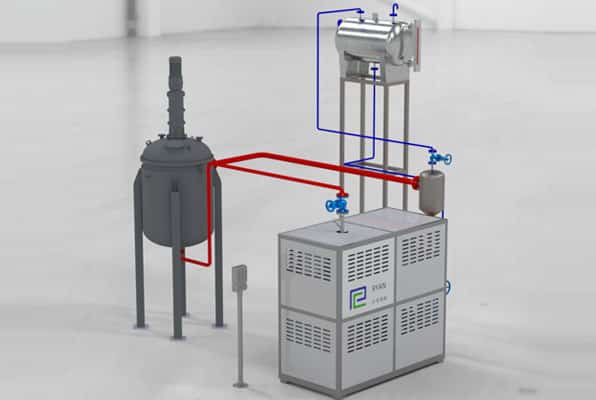In modern industrial heating systems, the electric heating thermal oil heater has become increasingly popular due to its high efficiency, safety, and environmentally friendly performance. Widely used in industries such as chemicals, pharmaceuticals, food, plastics, building materials, and textiles, this system offers a reliable solution for high-temperature heat transfer. In this article, we’ll dive into the working principle of electric thermal oil heaters, explaining their structure, operation, and advantages in detail.
1. What is an Electric Heating Thermal Oil Heater?
An electric heating thermal oil heater, also known as an electric thermal oil boiler, uses electricity to heat thermal oil (also called heat transfer oil), which then circulates through the system to transfer heat to the target equipment. Compared to steam boilers, this type of system operates under low pressure while achieving high temperatures, making it safer and simpler to manage.
2. Main Components of the System
A complete electric heating thermal oil system generally includes:
- Heater Body (Furnace): Contains electric heating elements that convert electrical energy into thermal energy.
- Thermal Oil Medium: A high-temperature synthetic or mineral oil that carries heat.
- Sirkülasyon Pompası: Moves the heated oil through the system to deliver heat to the required locations.
- Temperature Control System: Includes sensors, PID controllers, and an electric control panel for precise temperature regulation.
- Expansion & Storage Tank: Compensates for thermal expansion and stabilizes the system.
3. Working Principle in Detail
The working process of an electric thermal oil heater can be summarized in the following steps:
- Start-Up and Heating:
When powered on, the electric heating elements begin converting electrical energy into heat, raising the temperature of the thermal oil. - Heat Transfer Circulation:
The hot thermal oil is pumped to the process equipment that requires heat, such as reactors, ovens, or dryers. - Heat Utilization:
The oil transfers heat to the equipment through indirect heat exchange, heating the materials or maintaining desired temperatures. - Return and Reheat Cycle:
After releasing its heat, the cooled thermal oil returns to the heater to be reheated, creating a closed-loop cycle. - Temperature Regulation:
The control system constantly monitors and adjusts the oil temperature, typically maintaining it within ±1°C of the target (often between 150°C and 350°C).
4. Key Advantages
- ✅ High Thermal Efficiency: Nearly 100% of the electrical energy is converted to heat, with minimal thermal loss.
- ✅ Hassas Sıcaklık Kontrolü: Offers excellent control accuracy, ideal for sensitive processes.
- ✅ Environmentally Friendly: No combustion, no emissions, and no pollution.
- ✅ Safe Operation: Low-pressure system with no open flame or explosion risks.
- ✅ Easy to Use and Maintain: Fully automatic operation with low maintenance requirements.
5. Typical Applications
| Industry | Application Equipment | Heating Purpose |
|---|---|---|
| Chemical | Reactors, dryers | Constant-temperature processing |
| Food | Ovens, frying machines | Clean, smoke-free heating |
| Plastics | Extruders, calenders | Precise heating for molding |
| Pharma | Vacuum dryers | Controlled heating with no contamination |
6. Usage Tips and Precautions
- Regularly check or replace the thermal oil to prevent degradation or carbon buildup.
- Ensure proper pump operation to avoid localized overheating.
- Periodically inspect the heating elements for aging or damage.
- Leave space in the expansion tank to accommodate thermal expansion and avoid overflow.
7. Sonuç
Electric heating thermal oil heaters offer a safe, clean, and efficient solution for high-temperature industrial heating. Understanding how the system works allows users to optimize their setup, improve energy utilization, and reduce operating costs. As industries move toward smart and sustainable manufacturing, electric thermal oil heating systems will continue to play a key role in achieving efficient and eco-friendly production.

